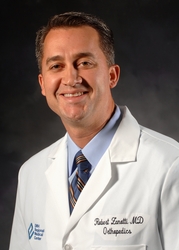
Platelet-Rich Plasma
Injections Treat the Underlying Cause of Knee Arthritis, Notes Cleveland-area
Orthopedist Robert Zanotti, MD
Platelet-rich plasma (PRP) injections use growth
factors in a patient’s own blood to help the body heal tendon injuries—and now
this natural therapy also shows promise in treating knee arthritis. The first
U.S. study of PRP as a viable means of managing knee osteoarthritis appears in
the December American Journal of Physical Medicine & Rehabilitation.
PRP is a form of Regenerative Injection Therapy, an emerging treatment
approach that helps stimulate the body’s ability to heal itself. Blood
platelets contain powerful healing proteins called growth factors.
Sheffield Village, OH (PRWEB) December 15, 2010
According to a pilot study published in the December American Journal of
Physical Medicine & Rehabilitation, platelet-rich plasma or PRP injections
produce significant improvements in pain and function among patients with
primary and secondary knee osteoarthritis.
“PRP injections have been popularized by pro athletes,” explains Robert Zanotti, MD, a board-certified orthopedic surgeon at the
Center for Orthopedics in Sheffield Village, Ohio, just west of Cleveland.
“Tiger Woods got PRP injections in his elbow, and Pittsburgh Steelers wide
receiver Hines Ward had them to treat a sprain in the medial collateral
ligament, or MCL, in his right knee,” says Dr. Zanotti, who is
fellowship-trained in sports medicine. “Now, we are using PRP injections at the
Center for Orthopedics to treat
Baby Boomers’ knee arthritis.
“PRP is a form of Regenerative Injection Therapy, an emerging treatment
approach that helps stimulate the body’s ability to heal itself,” Dr. Zanotti
explains. “Blood platelets contain powerful healing proteins called growth
factors. Conversely, cortisone injections treat arthritis symptoms by getting
rid of inflammation in and around the affected joint. PRP aims to address the
cause of arthritis; cortisone treats the effect.
“Inflammation is a part of the body’s natural healing response,” says Dr.
Zanotti. A study from the Netherlands presented at the 2010 annual meeting of
the American Academy of Orthopedic Surgeons suggests that PRP therapy is more
effective than cortisone injections in treating degenerating tendon tissue.
“PRP helps start the body’s inflammation and tissue regeneration cascade,”
Dr. Zanotti explains. “In a PRP treatment, blood is drawn from the patient. The
blood is then placed in a machine called a centrifuge, which spins it down to
separate the platelets from other blood components such as red and white blood
cells. This process, which takes just a few minutes, increases the
concentration of platelets up to 1,000%. Then the concentrated growth factors
are injected directly into the affected area to stimulate the patient’s
healing.
Dr. Zanotti emphasizes the need to choose PRP patients carefully. “PRP
isn’t for someone who’s 80 with total osteoarthritis,” he explains. “Ideal PRP
patients are those with early arthritis who have
good knee alignment, have probably had a knee scoped and cleaned out and have
been told they have small arthritic areas or OCDs—osteochondral defects. If
they’ve tried injections of cortisone or a lubricating gel such as Synvisc and
they’re still having discomfort, PRP can be a good option.”
Case in point: Ruth Ann Kanzeg, a 54-year-old nurse from LaGrange, Ohio who
developed stabbing pain in her knees. “It became uncomfortable to walk,” she
recalls. “I had to give up running and even jogging on a treadmill. When I went
to the orthopedist and saw my knee x-rays, I said, ‘I can’t have arthritis! Fix
this!’”
Kanzeg tried cortisone and Synvisc injections. She also had arthroscopic
surgery after she tore the lateral and medial meniscus in one of her knees.
In September, Kanzeg had a PRP injection in her left knee and it worked so
well that she had her right knee treated in October. “I feel wonderful!” she
says.
Just a month later, she took a trip to the Grand Canyon, where she hiked
and went on a mule ride. “I was the only one in our group who got off the mule
and didn’t have issues,” Kanzeg laughs. “After a mule ride, people usually have
problems with their back or knees—even people whose knees are normal. And I
didn’t have any problems. I was thrilled! I got off the mule and did a little
dance.
“I’m a very active person,” Kanzeg adds. “I’m 54, but mentally I’m a lot
younger. And I don’t want to stop doing the things I love to do. I don’t want
my body to slow me down. We Baby Boomers are taking care of everybody—our
parents, our children. Now we really need to take care of ourselves. And a big
part of that is staying healthy.
“The PRP injections have done a really good job,” she says. “I’m very
excited to get back to my normal activities without pain.”
PRP injections may not be covered by insurance plans.
For more information on PRP injections, visit http://www.center4orthopedics.com/procedures/PRP-injections. To
schedule a consultation with Dr. Robert Zanotti or any of the board-certified
orthopedic surgeons at Northeast Ohio's Center for Orthopedics, call
440.329.2800.
The Center for Orthopedics, part of EMH Regional Healthcare System, offers
the most comprehensive bone and joint care in Cleveland’s west side, western
Cuyahoga County and Lorain County, Ohio. Complete orthopedic care is available
from an expert team of five advanced-trained, board-certified orthopedic
surgeons at offices in Sheffield Village, Oberlin and Westlake, Ohio. Call
440.329.2800 or visit http://www.center4orthopedics.com.
Source:




Δεν υπάρχουν σχόλια :
Δημοσίευση σχολίου